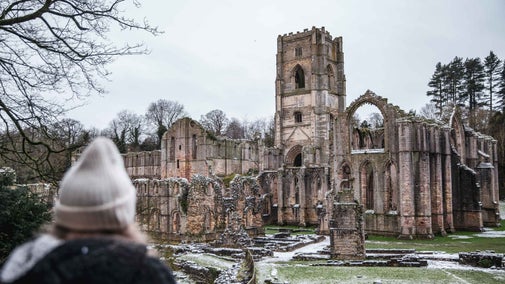
Discover more at Fountains Abbey
Find out when Fountains Abbey and Studley Royal Water Garden is open, how to get here, the things to see and do and more.

The National Trust manages over 4,000 deer in 12 parks in the UK. This management is an essential part of the work in the parkland and countryside cared for by the National Trust. Deer parks are often ancient pasture-woodlands and landscapes of great ecological and historical importance. They are also an important resource for everyone to enjoy.
Before the deer start having their young numbers in Studley Royal Deer Park are held at around 300; 120 Red deer, 120 Fallow deer and 60 Sika deer. There is another herd of around 40 Red deer in the area known as Mackershaw.
Our primary aim in both Studley Royal and Mackershaw Deer Parks is to maintain the herd in a healthy condition. We monitor the deer regularly – ensuring their welfare is of the utmost importance to us. The management of the deer park is year-round, our work involves repairs to the historic perimeter wall and fence repairs, checking the herd for injury and monitoring their health, raising awareness during calving, annual culling and winter feeding.
Deer have been managed in this landscape for hundreds of years. There are many deer parks in the care of the National Trust and our aim is to keep the deer as wild as possible, with minimal management.
The deer in Studley and Mackershaw are very lucky in that they have acres and acres of high quality grassland to munch on through the year, they also benefit from all the nut/seed bearing trees in the parkland. The Beech, Sweet Chestnut and Oak trees provide a large amount of additional food as their nuts fall to the ground in the autumn, this is great for the deer as they can gain a lot of weight before the summer starts. The deer can also be seen plucking leaves from the lower branches of trees to supplement their diets, this is why the trees all have uniformly flat bottoms to their canopies!
The ranger team supplementary feed the deer in the winter with fodder beet. This keeps tummies full, the deer happy and helps to lower the impacts grazing can have of grassland and trees when grass growth stops over the winter. Although we are looking to reduce the amount we feed through the winter, one of our main conservation aims in the parks is to manage our grassland.
We can all help to make sure the herd remains a healthy part of this ancient parkland.
Pick up litter
Litter left in the park can be very harmful to the deer when they are grazing, especially ring pull cans, metal screw top caps and broken glass. Dog mess (in bags or otherwise) is a growing issue in deer parks.
Keep your dog on a short lead
It’s not an uncommon event to find deer in the river with broken legs having fallen off the cliff faces after being chased or frightened by unleashed dogs. The deer are most vulnerable in June and July when they are calving. Even the best trained dog in the world has a natural instinct to hunt, and young calves can be attacked or killed.
Keep to the paths and look out for signs for closed areas
During the deer rut and annual cull, it’s important that visitors follow all signage in place, some of which will restrict access to certain areas – this is really important to help the team work safely.
Give the deer plenty of space
The rutting season is a special time of year to visit the deer park and we want everyone, both deer and people to stay safe. If you’re taking a photograph of the deer don’t creep up on them or surround them. Stand in the open where you can be seen as doing this reduces the chance of the deer acting aggressively. We advise against wearing camouflage.

Find out when Fountains Abbey and Studley Royal Water Garden is open, how to get here, the things to see and do and more.
The ruins of Fountains Abbey are truly something to behold. Discover what to see when you come face to face with some of the oldest abbey ruins in the country.

The evocative ruins of the abbey are set beside the grounds of Studley Royal, a medieval deer park in Yorkshire. It was declared Yorkshire’s first World Heritage Site in 1986.

Fountains Abbey is a three pawprint rated place. Discover why it's such a great place to bring your dog and take a look at our top tips to help you make the most of your visit.

Break up your adventures at Fountains Abbey and Studley Royal with some tasty refreshments. Afterwards, look for the perfect gift or a treat for yourself in the National Trust shop and plant centre.
